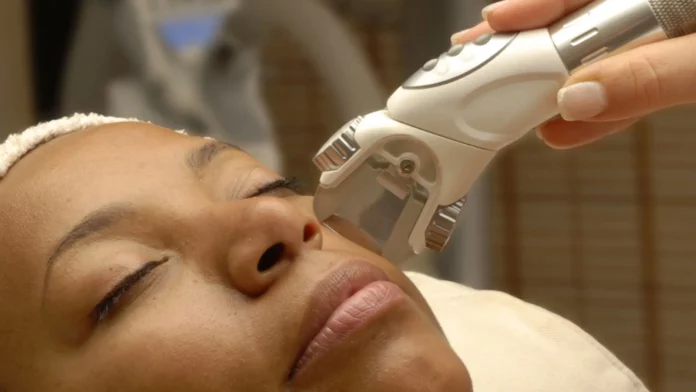Melasma is the brown hyperpigmentation that can appear on the face and neck (sometimes the chest
and arms). If you have been diagnosed with melasma you will know that it is something you have to
manage for the rest of your life. Which is incredibly daunting.
This type of pigmentation is made worse by sun exposure, so do you need to worry about it during the
winter months when it is undoubtedly less sunny?
In this article we take a quick look at why melasma develops and what you can do to treat it and manage
it when its cold(er) outside.
The term was used to designate a series of cutaneous melanisation processes, and its worsening was
reported to happen after sun exposure, fire heat, cold, and skin inflammations.
The How And The Why
Melasma is more likely to affect females and between 5-10% of people with dark skin tones. Melasma
can appear on a number of areas of the face, including the forehead, eyebrows, cheeks, chin, nasolabial
folds, upper lip, earlobes, or medial canthal lines. The discolouration can appear on the lower legs or
arms if they are exposed to lots of sunlight.
Unlike hyperpigmentation from the harsh Australian sun, which appears as random spots or freckles,
melasma appears in symmetrical patterns. Melasma can also be caused by changes in hormone levels
(hormonal treatments, pregnancy, birth control, and steroid usage), sunlight, and a genetic
predisposition, around 50% of all cases can be attributed to genetic history.
Sun exposure: This is the dominant reason that people develop hyperpigmentation as a result of the
over-activation of the skin’s melanocytes. These are the cells in the skin, hair, and eyes responsible for
the production of melanin. High concentrations or hyper-activation create areas of darker skin.
Hormones: These same melanocytes often act up during times of hormonal changes or imbalances,
including thyroid dysfunction. Similarly, menopause, birth control, and cosmetics affecting oestrogen
and progesterone have been linked to melasma.
Pregnancy: Melasma is also known as the “mask of pregnancy”, because it can develop as a result of the
hormonal changes caused by pregnancy.
Contributing diseases: Melasma can also be caused by diseases such as Addison’s, hemochromatosis,
and lentigines.
Winter Melasma Treatment
Winter is the best time of year to treat melasma as the weather is cooler and we are more likely to
spend time indoors. Sun avoidance means:
Less sun exposure
After any depigmentation treatment the skin becomes much more sun-sensitive, meaning it is more
likely to burn and take on photodamage. Exposing the skin to UV rays post-treatment can potentially
affect the results of the treatments and cause pigmentation to return.
The skin is usually less tanned
It should be mentioned that it is incredibly important to not use de-pigmentation treatments on tanned
skin (both natural and fake tan), as it can lead to increased risks of burns, post-inflammatory
pigmentation (PIH) and side-effects.
Now that we know winter is the best time to treat your melasma we have outlined some of the in-clinic
and topical treatments you can use to fade stubborn pigmentation.
Melasma treatments are varied, and the best results are usually seen when a combination of therapies
are used in tandem with vigilant management practices.
Prescription Melasma Treatment Cream: Over the last few years, we have seen more providers creating
personalised melasma treatment solutions for their patients. For example the Brisbane-based Qr8
MediSkin, designs and prescribes a treatment cream based on their patients’ lifestyles, and current
skincare routines.
This process begins with a questionnaire, followed by an online consultation with a doctor, who will
then diagnose your skin condition with the help of a complex 3D model of your face. The prescription-
only melasma treatment cream will have been clinically compounded specifically for skin sensitivity and
tolerance. Most patients will see noticeable improvement after three to six months of continuous use of
the cream or serum.
Microdermabrasion: A mildly abrasive instrument removes the top layer of skin to remove skin that
contains too much pigmentation. This treatment is also used to fade scarring, discolouration, sun
damage, and stretch marks.
Lasers: In certain cases where other treatments have failed to yield results, laser treatment can be
considered. However it should be cautioned that only either very low setting Q-switched Nd: YAG lasers
or fractional lasers are used to reduce the chances of post-inflammatory hyperpigmentation forming
after the procedure (this is more common with darker skin tones).
Chemical Peels: These in-clinic chemical peels are far stronger than any chemical peel you can get over
the counter. When it comes to melasma glycolic peels are the most popular and effective, while azelaic
acid reduces pigmentation from melasma in darker skin tones by working on hyperactive melanocytes.
Light Therapy: Melasma can be treated with intense pulsed light, where the resulting heat that is
generated breaks down pigment. Light therapy isn’t an exact science, as the heat can diffuse to the
surrounding skin and tissue. Like laser therapy, light therapy can have negative side effects like post-
inflammatory hyperpigmentation and a possible pigmentation relapse within three months of
treatment.
Keeping Melasma At Bay
What can you do to increase the effectiveness of your melasma treatment this winter? The main thing
you can do is reduce your exposure to UV rays!
The importance of using sunscreen even in the darker winter months cannot be stressed enough. While
we won’t be hibernating all winter long, sunscreen and proper sun protection is still in vogue. Outdoor
sports in the winter (especially if you are somewhere there’s snow and ice) means the sun’s rays are
now ricocheting off all of these reflective surfaces.
Once again, our friend the broad-spectrum SPF of 30 and higher is part of your skincare routine. UVA
and UVB light cuts through cloud cover, so even if you can’t see the sun, put it on. Sunglasses, hats, and
scarves are still on the protective clothing cards to help maximise your treatment results AND reduce
your chances of melasma reappearing once you have successfully faded it.

















